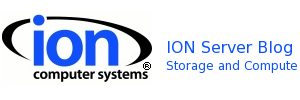ION® Computer Systems, Inc. recently published benchmark results for its SR-71mach5 SpeedServer™ running Microsoft® Windows® Server 2012 R2 with the SMB 3.1 protocol. Yes, the performance is “Disk-Impossible!”. A single 2U “mach5” system costing under $80k served 64kB random reads at 10 Gigabytes per second and delivered 8kB random reads at 1 million Input/Output Operations per second. Average latency as low as 1ms was recorded by clients performing random reads.
Configuration under Test
ION SR-71mach5 SpeedServer with:
- (3) all-SSD RAID 5 arrays with (8) Intel DC S3610 1.6TB SSDs each
- Intel® DC S3610 SSDs are Medium Endurance Technology (MET) drives intended for mixed read/write workloads.
- (24) 1TB partitions + (1) 1TB RAID 50 partition as (25) shares
- (10) 10Gb Ethernet ports using Jumbo Frames, 9014 bytes [5x Intel X520-DA2]
- (2) Intel® Xeon® E5-2690 V3 processors
- (8) 8GB 2133MHz DDR4 ECC DIMMs, 64GB total
- Microsoft Windows Server 2012 R2 Standard Edition
Clients:
- (5) Dual processor E5-2600 Series Servers
- (2) 10GbE COnnections each [1x Intel X520-DA2]
- Microsoft Windows Server 2012 R2 Standard Edition
- Each client mounted and tested (5) shares from the SR-71mach5 server
Tests:
- IOmeter 2006.07.27, each client system ran (1) dynamo manager.
- Each sytem ran one IOmeter dynamo manager with 1-2 workers per connected share, depending on teh selected test.
- Queue depth was set to 12 or 24 outstanding I/O requests.
- Each test ramped for 12 minutes and tested for 120 minutes.
- Each dynamo worker tested against an 800GB IOmeter-generated iobw.tst file on the shared partition.
- SQLIO v1.5.SG was also used to test performance of (5) clients using (5) shares each.
Summary and Detailed Reports at:
http://sr71.ioncomputer.com
Bandwidth
(10) 10Gb Ethernet connections were configured between the five clients and the SR-712mach5 SpeedServer, for a raw total of 100Gbps, or 12.5GBps, of available bandwidth. IOmeter was able to measure total delivered data at more than 10GBps to the five systems performing large reads, either randomly or sequentially. With 64kB random reads delivered at 10,464 MBps that works out to 167k IOPS with average latencu of just 7ms. SQLIO on the five test clients as also able to consume 64kB random reads at 9,949MBps and 64kB sequential reads at over 10GBps.
Input/Output Operations per second, IOPS
Would you believe that a standard Windows Server operating system on a standard server platform using common networking could deliver over one million IOPS? With five clients performing 4kB random reads, IOmeter measured 1,058,304 IOPS with an average latency of 1.13ms. And serving 8kb random reads, the SR-71mach5 server delivered just under 1M IOPS at 997,396 with an incredibly low average latency of 1.2ms. IOmeter measured its 64kB OLTP random read/write mix at 42,908 IOPS. Five clients running SQLIO with 8kB random reads generated 738,957 IOPS with sub-millisecond latency.
Latency
As mentioned above, Windows Server 2012 R2 on ION’s SR71-mach5 SpeedServer can deliver random reads at about 1M IOPS while maintaining disk-impossible average latencies of just over 1ms. Spinning-disk-based storage is limited by its mechanical design to latencie of 2ms or more. Expensive SSD caching can lower that in some solutions, but the success of the such caching depends on the randomness of the requests and the efficiency of the caching algorithm. SQLIO reported 0ms average latency, its way of expressing under 1ms, for 8kB random reads at 738k IOPS.
Summary
ION’s SR-71mach5 SpeedServer running Windows Server 2012 R2 Standard Edition delivers amazing SMB file server performance from a small, relatively inexpensive server occupying just 2 rack units and consuming less than 500W. Achieving 1M IOPS or over 10GBps or latencies as low as 1.13ms while serving random reads would typically require much more space and much more power at a much higher cost.
